The most effective way to enjoy clean, filtered water throughout your entire home is to install a whole house water filter system.
Conveniently, these systems don’t require much maintenance. But you’ll still need to clean your system from time to time to keep it in good working order.
In this guide, you’ll find the steps you need to take to clean and sanitize your whole house water filtration system.
📌 Key Takeaways:
- To clean a whole house water filter, shut off the water supply & remove the filter housings and cartridges. Use hot, soapy water & brush to clean the housings.
- Cleaning a whole house filtration system will prevent a buildup of debris inside the filter housings, which could cause the filters to get stuck and re-contaminate new filters.
Table of Contents
📖 How to Clean a Whole House Water Filtration System: Step-By-Step
Ready to clean a water filter installed at your home’s point of entry? Follow these steps:
Step 1: Shut Off Your Water Supply
First, find the valve that controls the supply of water into your home, and turn the valve to shut off the water.
Alternatively, shut off the valve at your water pressure tank, or shut off the power to your well pump.
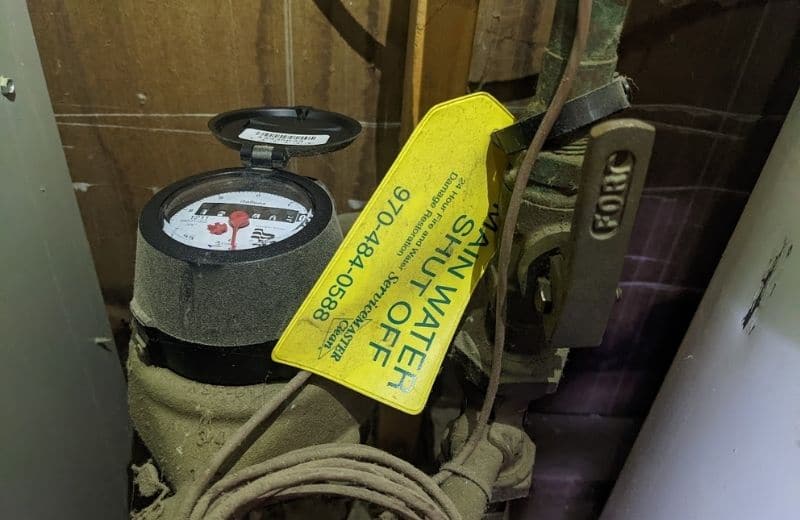
Step 2: Release The Water Pressure
To release water pressure in the pipes, open your nearest faucet and allow the water to drain.
If your water filter system has a pressure release button (usually found on top of the filter housing, colored red), press this to relieve pressure inside the housing. Hold a rag against the button to catch leaks.
Step 3: Remove The Filters
Most whole house water filters are made up of numerous filter housings and cartridges.
Remove and clean each filter housing one-by-one, to avoid confusion when you go to screw the casing (either with your hands or with the plastic wrench included with your purchase).
Twist the casing to the left. You should feel it come loose and unscrew from the main unit.
After removing the housing, slide out the old water filter cartridge and get rid of any leftover water. Clean the o-ring, or replace it if it’s cracked or worn.
Check the cleanliness of the housing. If you spot algae, mold, or debris, it should be cleaned.
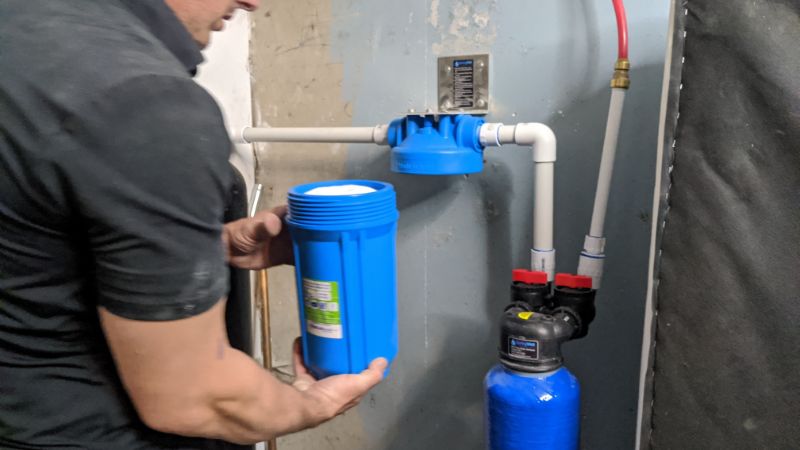
Step 4: Clean the Filter Housing
Let the housing for the first filter soak in a tub of warm, soapy water for 5-10 minutes, then use a sponge to clean out the inside of the casing and the caps.
Rinse the housing and check that everything has been removed, then wipe it thoroughly clean with a cloth.
Step 5: Discard Or Replace Cartridges
Take this time to inspect your old filter and decide whether or not it needs to be replaced.
If the filter looks very dirty, has expanded so much that you struggle to return it to the housing, or has reached the end of its expected lifespan, replace it with a fresh cartridge.
If your filters are becoming clogged too quickly, you might need to install a dedicated sediment filter upstream of your filtration system.
Step 6: Screw The Filter Housing Back On
After cleaning the housing and replacing the cartridge (if necessary), screw the housing back onto the unit, hand-tightening or using the provided housing wrench.
📌 Don’t use a metal wrench to tighten the housing as this could damage the unit due to overtightening.
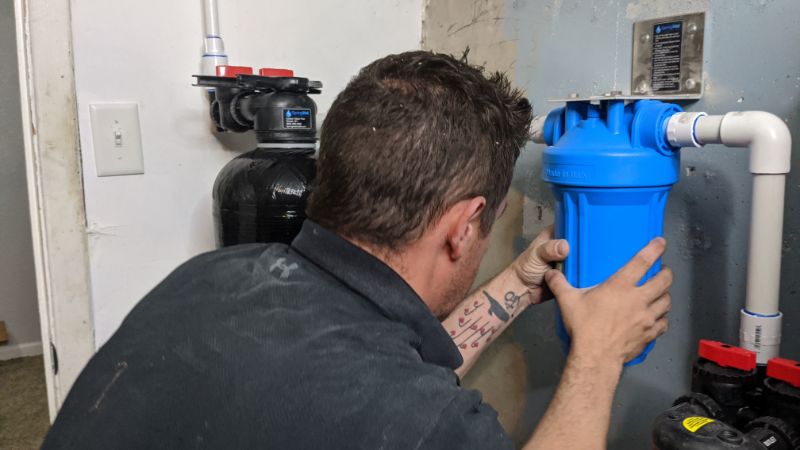
Step 7: Repeat With Other Housings
Once one housing is clean and ready for use, repeat the steps above with your other filter housings.
You’ll probably find that your sediment filter housing is the dirtiest, and every subsequent housing is slightly cleaner than the last.
Step 8: Switch On Water & Check For Leaks
After cleaning and reinstalling all the filter housings, gradually turn on your whole home water supply and check the unit for leaks.
📌 If you notice a leak, you might not have properly fitted the o-ring, or the housings might be under-tightened or overtightened. Switch off the water supply and resolve the issue.
If there are no leaks, go ahead and turn on your water supply all the way, then open the nearest faucet and wait for a steady stream of water to leave the tap.
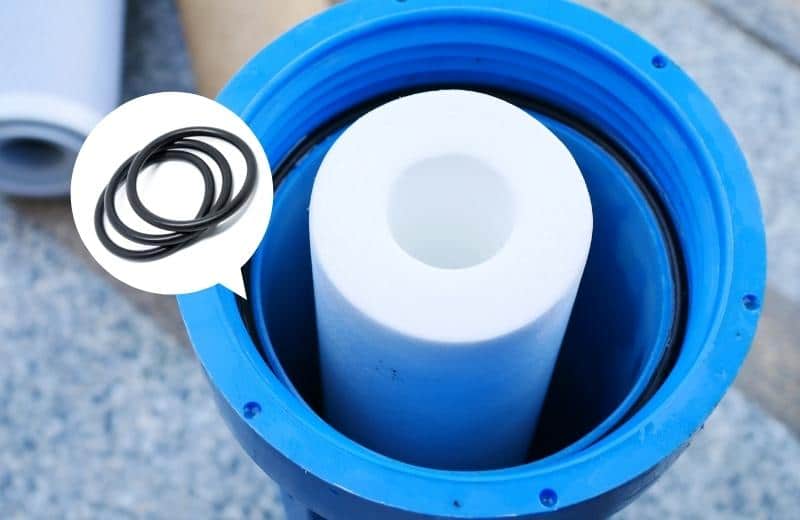
Optional Step: Sanitize The Housing
Sometimes, a soak in warm water might not be enough to thoroughly clean a particularly dirty filter housing.
We recommend creating a sanitizing solution for very dirty housings by diluting 1/3 teaspoon of unscented bleach in 1 gallon of tap water.
Remove all the cartridges from the housings, then fill each housing with 1 cup of the sanitizing solution. Screw the housings back onto the unit, then open your whole home water valve to send water through the unit.
Open a nearby faucet and wait for water to leave the tap. Then, switch off the faucet and leave the solution to sanitize the filtration system for 20-30 minutes.
Finally, shut off your water valve and unscrew the filter housings. Drain and rinse the housings, return the cartridges, and connect them back up to the unit. Run several faucets around your home for 5-10 minutes to drain the bleach out of your water supply.
Further Reading:
- Whole home water filtration system reviews
- How to bypass a whole house water filter system
- Reviews of the best whole house water filter cartridges
🧽 How Often to Clean a Whole House Water Filter System
You should aim to sanitize your whole house water filter system at least once a year.
If you have water with high TDS, such as well water, you may need to clean your filter housing more frequently.
Hard water scale, sediment, and iron may all damage your filtration system over time. Prevent permanent staining by checking and cleaning your filter system when needed.
🚰 Why Should You Clean a Whole House Water Filter?
There are a few key reasons why you should clean your whole house water filter system:
- To prevent bacteria buildup. Over time, the damp, humid environment inside your water filter system might cause bacteria to accumulate inside the filter housing. The best way to avoid this is to clean out the housing regularly.
- To avoid contaminating the new filters. Let’s say it’s time for you to replace your filters. As you remove the filter cartridge, you notice that the housing is dirty. You ignore it and install the new cartridge. Once water starts flowing through the system, the debris inside the housing will contaminate the new filter cartridge.
- To prevent the filters from getting stuck in the housing. Sometimes, a filter might get stuck in the filter housing due to a buildup of debris inside the system. Removing a stuck filter is difficult, so it’s worth trying to avoid this by cleaning out the housing from time to time.
- To maintain a fast filtration speed. Too much dirt in your water filters could reduce your water filtration speed. Cleaning your system and replacing the filters on time will help you maintain a good flow rate.
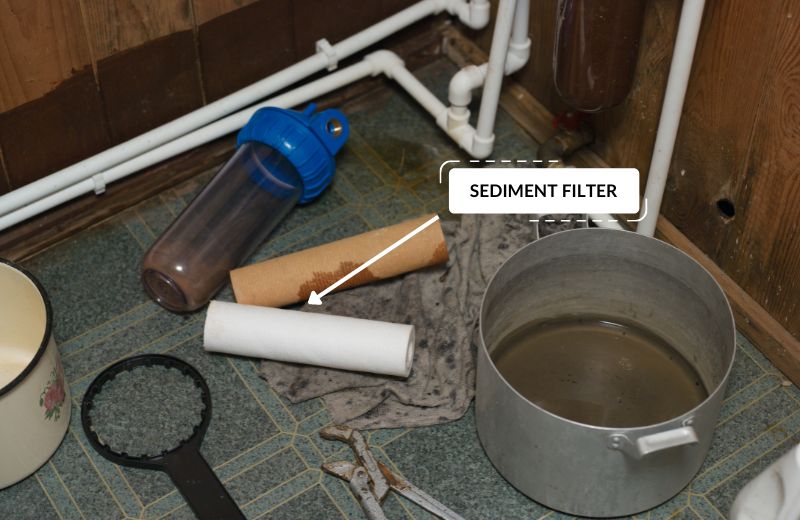
🔂 Can You Clean & Reuse Whole House Filter Cartridges?
We don’t usually advise cleaning and using the cartridges in a whole house filter cartridge system.
Most filter cartridges aren’t designed to be reused. Once they’re saturated with contaminants, they need to be thrown out and replaced.
You might be able to clean some cartridges by sending water in the opposite direction through the filter to remove the contaminants. However, this could damage the filter media and cause contaminants to leak back into your water supply – and it won’t get the filter cartridge back to like-new condition, anyway.
With that said, there are a couple of filter types that may be somewhat restored by cleaning: sediment filters and carbon filters.
Cleaning Sediment Filters
Some sediment water filters can be cleaned with a pre-mixed cleaner, like an oxalic acid and muriatic acid mixture.
To clean sediment filters:
- Mix your chosen acid solution with 1 gallon of water, then soak the filter (in its housing) in this solution
- After about 20 minutes, rinse the filter and housing with cold water
- Finally let the filter air-dry before reattaching the housing to the unit
To restore filtration speed and improve performance, cleaning works best on pleated sediment filters made from synthetic fibers – but it’s not well-suited to other paper models.
Cleaning Carbon Filters
Some carbon water filters might also be reusable (although the manufacturer probably won’t recommend it).
To clean a carbon filter:
- Cut around the outside of the plastic mesh netting then remove this netting.
- Cut the paper layer beneath the netting, leaving about 1/2 inch of paper to make it easier to roll back up once you’re done.
- Peel the outer paper layer away and wash the carbon media with water from a garden hose.
- Use a brush to clean both sides of the paper layer.
- Dilute 2 teaspoons of bleach in warm water, then place the carbon filter in this solution and leave it to soak for about 5 minutes.
- Remove the filter from the solution, rinse it thoroughly, then tightly roll the paper layer and use several nylon ties to secure it back in place around the filter media.
❔ How to Clean a Whole House Water Filtration System: FAQs
What’s the best cleaner to use in a whole house water filter?
The best cleaner to use in a whole house water filter is water mixed with dish soap. This should lift most stains from the housing without the need for anything stronger. If you’re dealing with stubborn stains, soak the housing in equal parts water and distilled white vinegar before you attempt cleaning.
How often should I change the filters in my whole house water filter system?
You should aim to replace your whole house water filter cartridges every 6-12 months, or as advised in your user manual. Make sure to replace your filters on time to prevent an old filter from accumulating bacteria or re-contaminating your water.
How do you deep clean a water filter system?
To deep clean a water filter, mix equal parts vinegar and warm water, then dip the filter housing in the solution. Use a sponge to scrub the debris out of the housing. If you choose to use bleach or another harsh cleaner, make sure it’s properly diluted to prevent it from damaging the housings or contaminating your water once you reinstall the cartridge.
How long does it take to clean a water filter?
The whole cleaning process takes about 15 minutes for complete filter systems. If you need new filter cartridges, you plan to sanitize the housing, or the housing needs a long soak, the cleaning will take a little longer.
How do you clean a whole home reverse osmosis system?
To clean a whole house reverse osmosis system, use an NSF-approved cleaner or unscented bleach. Shut off your water supply and drain the RO tank, then remove the sediment & carbon block filters and reverse osmosis membrane. Add the cleaner to the sediment pre-filter housing, then return all the housings without new filters. Flush the system, then drain and refill the tank with feed water.

